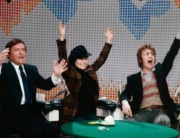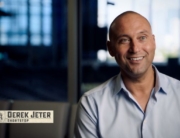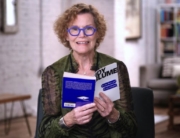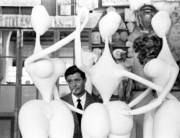
Salvatore Ferragamo, as seen in Salvatore: Shoemaker of Dreams (Archivio Giuseppe Palmas/Sony Pictures Classics)
You don’t have to be a shoe buff to watch Luca Guadagnino’s Salvatore: Shoemaker of Dreams, but it helps. “I love feet–they talk to me,” intones the footwear designer Salvatore Ferragamo in voice-over, and fashionistas like Grace Coddington manipulate soles of his footwear and gush over the invention of his cork wedge heel. A wordless sequence at the beginning of the documentary depicts an intricate pair of shoes coming together step by step in a high-tech Ferragamo factory. Though an often flamboyant filmmaker in the fictional realm, Guadagnino seems to be trying to work himself into a passion with this endeavor, which profiles admirable achievements but becomes an odd combo—a fawning yet dry tribute.
Granted, Guadagnino doesn’t have much footage to work with for crucial stretches of his time frame. The 11th of 14 children from a poor Italian farming family, Ferragamo was fascinated by shoemaking from the age of three and lit out at 11 for an apprenticeship in Naples in 1909. The hypertalented ragazzo was developing his own brand by 12. Guadagnino re-creates these crucial years with a hushed, worshipful NPR–style narration from actor David Stuhlbarg that brings no oomph to the biography. The shoemaker’s travels are reenacted with shots of long stretches of road that first seem lyrical, then begin to unspool monotonously like leftover B-roll from car commercials.
Not that Ferragamo’s life was uninteresting. Far from it. Ferragamo ventured from Italy to Boston, then to the then-center of the film industry, Santa Barbara, and from there to Hollywood. He socialized with Gloria Swanson and whipped up spaghetti for fellow paisano Rudolph Valentino. Making shoes for major Hollywood epics like The Ten Commandments taught him to work at scale and experiment with materials, striving for a confluence of comfort, esthetics, and creativity. Along the way, Ferragamo dealt with a catastrophic car accident (he designed his own elegant splint), a move back to Italy, bankruptcy, and the Great Depression. Work and artisanship always lifted his spirits. “I am not destitute,” he recalls after a setback. “I had my hands and my brain and these working people faithful to me.”
Ferragamo speaks for himself in the film’s best moments. Though Guadagnino interviews shoe designers Christian Louboutin and Manolo Blahnik, they don’t have much to say about Ferragamo’s place in the fashion pantheon. A round of chortling asides are contributed from Martin Scorsese, endlessly tickled by his own observations that aren’t very amusing. Ferragamo’s attractive extended family express loyalty for the brand and offer supportive comments about his marriage, which we don’t get much of a handle on. (Although his wife, Wanda, who died in 2018, thanks him on camera, “for your great contribution to feminine elegance.”) More footwear fetishism reaches its peak as costume designer Deborah Nadoolman gloats over an enormous curved Keebler-elf shoe: “Can you imagine Douglas Fairbanks wearing this?”
Not over-the-top enough to be fabulous, not deep enough to be sincere, Salvatore never really kicks off its shoes and finds a groove.
















Leave A Comment